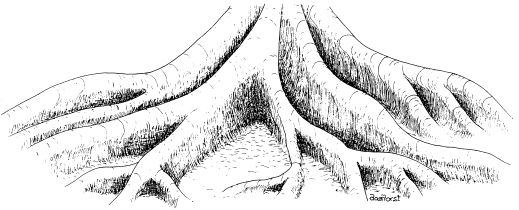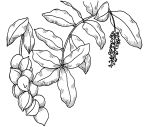


Aboriginal Plant Use Student Guide S
Plant activities
1. River Red Gum - One Stop Shop

(a) This tree was like a supermarket for the local Adelaide Plains Kaurna people.
Take a close look at the tree and complete the following table to find out why it was a one stop shop.
|
Traditional Use |
Part of Tree |
How Obtained |
|
Kitchen Bowl |
||
|
Canoe |
||
|
Honey |
||
|
Meat |
||
|
Coats |
||
|
Medicine for colds |
||
|
Eggs |
2. Moreton Bay Fig - Fig Cakes

(a) Comment on the size of these
Size of Tree: ______________________ 
Amount of Fruit: _____________________
(b) What is the problem with a lot of ripe fruit at once ?
_________________________________
(c) How do you think Aboriginal people overcame this ?
__________________________________
3. Yacca - Fire

Take a close look at this plant.
Resin glue leaves
Salad vegetable flower stem
Fire trunk
(b) Why did Ngarrindjeri people have to be careful when collecting nectar and seed from the top of this plant ?
________________________________________
(c) An Adnyamathanha dreaming story warns not to grab onto a type of yacca when climbing steep ravines.
Why ? ________________________
(d) The resin glue was traded or used as a type of currency.
What made it so valuable ? _______________________________
4. Ribbon Gum - Tasty Tucker

(a) What animal lives in the winding holes in this tree. ____________________
(b) Design and sketch a tool you think Aboriginal people made to get them out.
(c) What did they look for as evidence a grub is living inside ?
5. Banksia - Refreshing Cordial

Look closely at the plant.
(a) What part could be used to filter water ? _________________________
(b) Describe how it could be done. ________________________________
(c) What part do you think was used to make a sweet cordial drink ? _________
6. River Red Gum - Hollow Tree

a) Sketch what you see here.
|
My Sketch |
(b) How was this tree used by the Kaurna ________________________________________
(c) How did they modify the tree ? _______________
(d) How do you know ? _______________________
(e) Why was it important they did not stay here too long ?
_________________________________________
7. Macadamia - Food for Thought
Aboriginal people made many different stone tools.
(a) Circle the best Macadamia nut cracker. 
(b) Give two reasons why it is well designed for breaking open this very hard nut.
1. ______________________________2. ______________________________
 Each spray of 40 to 50 macadamia flowers produces from four to fifteen ‘nutlets’ which will eventually ripen into nuts.
Each spray of 40 to 50 macadamia flowers produces from four to fifteen ‘nutlets’ which will eventually ripen into nuts.
(c) What is the smallest number of nuts from a mature tree ? _________
(d) What is the largest number ? ___________
(e) Estimate the weight of nuts a fully grown macadamia tree can produce in one year ?
25kg 55kg 105kg
8. Pisonia - Bird Trap

Look closely at the leaf size and leaf colour.
(a) Circle the type of environment you think
this plant might come from:
Desert Mallee Rainforest
The sticky fruits on this tree were used to trap ground walking birds.
(b) Draw how the trap might have worked.
(Hint: include a bird, the sticky fruits and a fruit lure.)
(c) What was the advantage of using traps to catch animals ?
9. Bottle Tree - A Lifesaver

(a) How do you think the tree was used during
long, dry season in
(Hint: note the shape of the trunk.)
_________________________________
(b) Cuts were made to the bark of this tree. The edible, starch rich sap which oozes from the tree to seal the wound was scaped off and eaten.
Look for evidence of natural scarring on the trunk of this tree.
How do you think these scars were formed ?
___________________________________
(c) The dotted lines on the drawing indicate another use, what was it ? ______
10. Macrozamia - Danger Poison !

Look for cones growing on these plants. 
The starch-rich seeds inside the cones are poisonous
yet Aboriginal groups throughout
used them for making damper.
(a) How could they have made the seeds safe to eat ?
_____________________________________
(b) Macrozamias groves were deliberately burnt by Aboriginal people.
Why might they have done this to one of their food supplies ?
_____________________________________
11. Foam-bark - Gone Fishing

This tree was used for fishing in ponds or dammed streams. It did not provide spears, hooks, clubs, or any other normal fishing tackle. The method was so good for hunting that the fish actually floated up to the hunter.
(a) Explain how you think the tree was used to catch fish.
(b) What were the advantages of fishing this way ?
______________________________________________
(c) What were the disadvantages ? ________________________________________________
(d) How do you think they were overcome ? _________________________________________
12. Flax-lily - A Splash of Colour

Look closely at the leaves.
(a) How do you think they were used by Aboriginal people ? _____________________
(b) This plant is:
about to fruit in fruit finished fruiting not fruiting
13. Casuarina - Hunting

Enjoy the peace and shade in this lovely grove of trees.
(a) What sort of tools could be made from the thin saplings in this area ?
________________________________________________
(b) Sketch a the part of a larger tree which could be used to make the following weapons.
Boomerang
Spear Thrower
Club
14. Think About It
Here are a few questions to help you think about what you have learnt along the trail.
1. (a) What was the most interesting plant use story ?
(b) What made it interesting for you ?
2. How has the trail changed the way you think about Aboriginal people and their relationship to the land ?
3. Why do you think its has taken up until recent times for the wider community to take a much greater interest in Aboriginal knowledge of the environment ?
4. In what ways could the things you learnt along the trail be of use to you in the future ?
5. Compare traditional use of the land with the way we use the land today.
6. Many tourists who come to
(a) Do you think they would find this type of trail interesting ? Why ?
(b) Why do many people think trails like this should be guided by
Aboriginal people ?
7. Having completed the walk, why do you think botanic gardens are sometimes called ‘living museums’ ?
